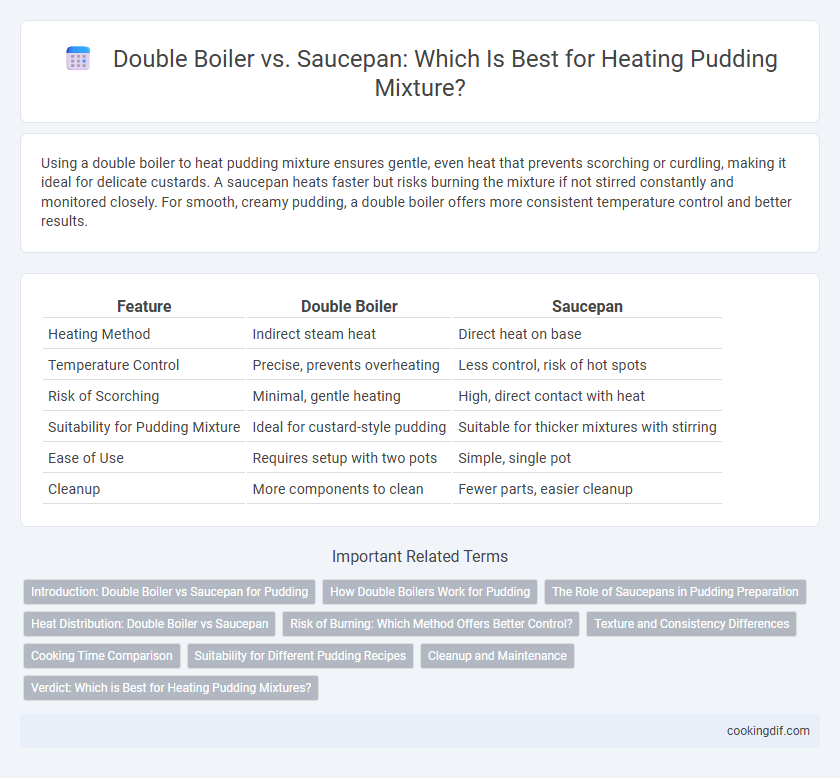Using a double boiler to heat pudding mixture ensures gentle, even heat that prevents scorching or curdling, making it ideal for delicate custards. A saucepan heats faster but risks burning the mixture if not stirred constantly and monitored closely. For smooth, creamy pudding, a double boiler offers more consistent temperature control and better results.
Table of Comparison
| Feature | Double Boiler | Saucepan |
|---|---|---|
| Heating Method | Indirect steam heat | Direct heat on base |
| Temperature Control | Precise, prevents overheating | Less control, risk of hot spots |
| Risk of Scorching | Minimal, gentle heating | High, direct contact with heat |
| Suitability for Pudding Mixture | Ideal for custard-style pudding | Suitable for thicker mixtures with stirring |
| Ease of Use | Requires setup with two pots | Simple, single pot |
| Cleanup | More components to clean | Fewer parts, easier cleanup |
Introduction: Double Boiler vs Saucepan for Pudding
A double boiler provides gentle, even heat crucial for preventing pudding mixtures from curdling or burning. Saucepan heating risks direct high heat contact, often causing uneven cooking or scorching of delicate pudding ingredients. Choosing a double boiler ensures smoother texture and consistent temperature control essential for perfect pudding results.
How Double Boilers Work for Pudding
Double boilers gently heat pudding mixtures by using steam from simmering water in the lower pot to warm the upper pot without direct contact with heat. This method prevents scorching and curdling, ensuring smooth and creamy pudding texture. Unlike saucepans, double boilers maintain consistent low temperatures, which is ideal for delicate custards and chocolate-based puddings.
The Role of Saucepans in Pudding Preparation
Saucepans play a crucial role in pudding preparation by providing direct heat to the mixture, ensuring quicker temperature increase compared to a double boiler. Their ability to maintain consistent heat is ideal for recipes requiring gradual thickening, though careful stirring is necessary to prevent scorching. Selecting a heavy-bottomed saucepan enhances heat distribution, reducing the risk of uneven cooking and improving the pudding's texture.
Heat Distribution: Double Boiler vs Saucepan
A double boiler provides gentle, even heat distribution by using steam to warm the pudding mixture, preventing scorching or curdling. In contrast, a saucepan applies direct heat, which can cause hot spots and requires constant stirring to avoid burning. This makes a double boiler the preferred choice for delicate pudding mixtures needing controlled, consistent heat.
Risk of Burning: Which Method Offers Better Control?
Using a double boiler to heat pudding mixtures significantly reduces the risk of burning by providing gentle, indirect heat that prevents the custard from scorching. In contrast, a saucepan applied directly over heat demands constant stirring and vigilant temperature control to avoid curdling or sticking to the pan's bottom, increasing the risk of uneven cooking or burning. Chefs prefer double boilers for delicate pudding preparation due to their superior temperature regulation and consistent heat distribution.
Texture and Consistency Differences
Using a double boiler for heating pudding mixture ensures gentle, even heat, preventing curdling and resulting in a smooth, creamy texture with consistent thickness. In contrast, a direct heat saucepan can cause uneven cooking and higher risk of scorching, leading to a grainy texture and inconsistent consistency. The controlled temperature of a double boiler preserves the delicate structure of custard-based puddings, enhancing overall mouthfeel and preventing lumps.
Cooking Time Comparison
A double boiler typically heats pudding mixtures more slowly and evenly, preventing scorching and ensuring smooth texture, but it extends the cooking time compared to a saucepan. Saucepans conduct heat directly, speeding up the cooking process but increasing the risk of uneven heating and curdling if not constantly stirred. For delicate pudding recipes, the double boiler's longer cooking time offers better control without compromising quality.
Suitability for Different Pudding Recipes
A double boiler ensures gentle, even heat distribution ideal for delicate pudding recipes like custards or chocolate puddings that require precise temperature control to prevent curdling or burning. A saucepan suits thicker, more robust pudding mixtures such as rice or bread puddings where direct heat accelerates cooking and thickening without the risk of scorching when stirred continuously. Choosing between a double boiler and saucepan depends on the pudding's texture and cooking sensitivity, with the double boiler being preferred for smooth, creamy results and the saucepan for hearty, textured puddings.
Cleanup and Maintenance
Using a double boiler for heating pudding mixtures significantly reduces the risk of scorching, making cleanup easier as food residue is less likely to stick to the inner pot. Saucepans often require more thorough scrubbing due to direct heat causing mixture to burn onto the surface. Double boilers typically feature detachable parts that can be soaked separately, simplifying maintenance compared to single-piece saucepans.
Verdict: Which is Best for Heating Pudding Mixtures?
Using a double boiler for heating pudding mixtures ensures gentle, even heat distribution, minimizing the risk of curdling or burning. A saucepan offers quicker heating but requires constant stirring and close attention to prevent scorching the delicate mixture. For consistently smooth and creamy pudding, the double boiler is generally the best choice despite taking more time.
Double boiler vs saucepan for heating pudding mixture Infographic

 cookingdif.com
cookingdif.com